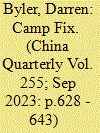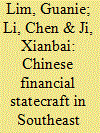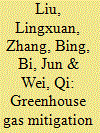|
|
|
Sort Order |
|
|
|
Items / Page
|
|
|
|
|
|
|
| Srl | Item |
| 1 |
ID:
192624


|
|
|
|
|
| Summary/Abstract |
Industrial parks in north-west China occupy a liminal space between labour camps and private industry. Drawing on worker interviews, government documents, industry materials and images this article shows that for-profit public-private industrial parks have been built as part of a “camp fix” mechanism centred on detaining and “re-educating” Uyghurs and Kazakhs at the periphery of the nation. It argues that these industrial parks concentrate forms of repressive assistance and “dormitory labour regimes” that operate at other frontiers of Chinese state power and point these strategies of disempowerment towards a seemingly permanent, ethno-racialized underclass, producing a “re-education labour regime.” It further argues that the material infrastructures of these surveiled and policed spaces themselves are productive in enforcing the goals of the “camp fix”: the creation of high-quality, underpaid, docile and non-religious Muslim workers who are controlled through the built environment.
|
|
|
|
|
|
|
|
|
|
|
|
|
|
|
|
| 2 |
ID:
185987


|
|
|
|
|
| Summary/Abstract |
Since 2013, the Belt and Road Initiative has become China’s signature foreign economic policy campaign. While there have been debates on the initiative’s implementation and implications, an emerging consensus suggests that the export of capital-intensive infrastructure is a key driving factor of China’s financial statecraft. For Southeast Asian countries, such Chinese efforts are useful in plugging their domestic infrastructure gaps, not least in the remote parts of their territory. Against this backdrop, this article examines arguably two of the most prominent Chinese infrastructure projects in Malaysia – the East Coast Rail Link (ECRL) and the Malaysia-China Kuantan Industrial Park (MCKIP). It posits three inter-related arguments. Firstly, unlike conventional analyses which commonly treat the Chinese state as a singular, unitary actor, both the central and provincial governments in China’s multi-layer state structure have played important roles and demonstrated different characteristics in Chinese infrastructure overture towards Malaysia. Secondly, one observes contrasting patterns of well-coordinated state-business relations in the ECRL project versus loose, decentralised state-business relations driven largely by Guangxi province and market forces for the MCKIP. Thirdly, the implementation of both the ECRL and the MCKIP has been heavily constrained by the political-institutional environment of Malaysia as the host country, illustrating that Chinese financial statecraft, in the form of infrastructure provision, generates considerably less impact than what popular rhetoric suggests.
|
|
|
|
|
|
|
|
|
|
|
|
|
|
|
|
| 3 |
ID:
112911


|
|
|
|
|
| Publication |
2012.
|
| Summary/Abstract |
Climate mitigation at the local level plays a highly important role in greenhouse gas (GHG) emissions mitigation. This research presents a summary of the local efforts in China's ecological industrial parks (EIPs) to assess GHG emissions and identify potential mitigation measures. Through field study and interviews in Suzhou Industrial Park (SIP), in Jiangsu Province, we conducted an energy-based GHG emissions inventory for SIP area from 2005-2010, with forecasts to 2015. The area emitted a total of 10.30 MMT CO2E in 2010. Three development strategies including business-as-usual (BAU), existing and pending regulations (EPR) and voluntary mitigating efforts (VME) were introduced to estimate the energy-related GHG emissions in 2015. The results projected that emissions will increase to 17.16 Mt in 2015 with no change in policy or practice, but 3.42 Mt of emissions are avoidable with full compliance with national and provincial energy policies (1.41 Mt), as well as local efforts (2.01 Mt). This study furthers the understanding of the potential effectiveness of carbon reduction strategies of industrial parks in China, including the development industrial symbiosis (IS) and on-site renewable energy projects.
|
|
|
|
|
|
|
|
|
|
|
|
|
|
|
|
|
|
|
|
|